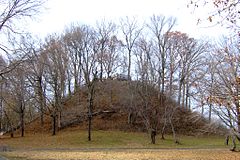Pinson Mounds
| Pinson Mounds State Archaeological Park | |
|---|---|

Sauls' Mound (Mound 9) at the park
|
|
| Type | Tennessee State Park |
| Location | Pinson, Tennessee |
| Area |
1,200 acres (4.9 km2) |
|
Pinson Mounds
|
|
| Location | Madison County, Tennessee |
| Coordinates | 35°29′52″N 88°40′57″W / 35.49778°N 88.68250°WCoordinates: 35°29′52″N 88°40′57″W / 35.49778°N 88.68250°W |
| Built | 0-499 AD |
| Website | tnstateparks |
| NRHP Reference # | 66000727 |
| Significant dates | |
| Added to NRHP | October 15, 1966 |
| Designated NHL | January 29, 1964 |
1,200 acres (4.9 km2)
The Pinson Mounds comprise a prehistoric Native American complex located in Madison County, Tennessee in the region that is known as the Eastern Woodlands. The complex, which includes 17 mounds, an earthen geometric enclosure, and numerous habitation areas, was most likely built during the Middle Woodland period (c. 1-500 AD). The complex is the largest group of Middle Woodland mounds in the United States. Sauls' Mound, at 72 feet, is the second-highest surviving mound in the United States.
The Pinson Mounds are now part of Pinson Mounds State Archaeological Park, one of two archaeological parks in Tennessee (the other being Old Stone Fort near Manchester). Pinson Mounds is a National Historic Landmark and is listed on the National Register of Historic Places.
The Pinson Mounds are located on a plateau-like upland above the wetlands that line the banks of the South Fork of the Forked Deer River. The river and its wetlands form the complex's southern boundary. The Pinson Mounds are located amidst three distinctive biotic zones: the oak forests atop the plateau, the cypress forests in the wet bottomlands, and the beech forests on the slopes between the uplands and the bottomlands. The ground is mostly composed of Tertiary period rocks known for producing high-quality clay.
The mounds complex can be roughly divided into three sections— the Inner section, situated at the center of the complex around Saul's Mound, the Western (or Ozier) section, and the Eastern section, which includes the geometric enclosure. A stream known as Hudson Branch runs perpendicular to the Forked Deer River and divides the Inner section from the Western section. The Eastern and Western sections are both roughly 1,500 meters from the Inner section. (click for map)
...
Wikipedia
